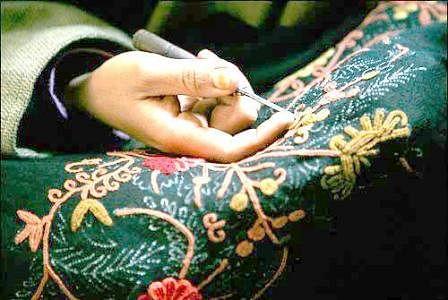As of now, no step has been taken by the government to fortify the chain stitch art in Kashmir.
Besides a breathtaking natural beauty, kashmir is celebrated for its rich culture as well as the mastery of its denizens in different fields of art. The rich soil of Kashmir has produced countless artists who with their skill attracted attention round the globe.
Chain stitch is among the numerous arts Kashmir can be genuinely proud of. Handmade chain stitch rugs of Kashmir are usually cherished outside the country. Kashmir’s handicrafts, including carpets are sold in the Middle-East and European market. The Valley mainly exports handicrafts such as silk carpets, crewel, namdah, chain stitch, wood carving and paper machie.
Chain stitch is a sewing and embroidery technique in which a series of looped stitches form a chain-like pattern. Chain stitch locally called tebi kaam or feete kaam, is done with a hook ( called Ari in Kashmir) using multicolored wool on tightly woven fabrics like linen and cotton. Chain stitch has been inspired by the enchanting natural beauty of Kashmir, hence motifs like Booen (chinar), Badam (Paisley), Yemburzal (Narcissus), Daenposh (pomegranate) and Pamposh (lotus) are the most popular and repeatedly employed motifs.
“It looks like someone has accursed our bread earning taeb kaam (chain stitch)” , says my father M Maqbool Bhat, who has been an avid chain stitch worker cum distributor since 1970. “It was a hope for the poor and a fair means to earn bread and butter in the villages”, he adds, while letting the past memories take over his mind. He recollects how he would be adored by his workers because of his honesty, love, care, compassion and consideration. He would teach his village-mates this art free of cost, and would motivate them to earn livelihood by fair means. “Yes, there were other distributors in our area as well”, he says, “but people usually flocked to me because I would never compromise my ingrained principles for petty material gains” . All the employees of my father used to work together in a separate room of our home which was called czhaart haal (workplace). “Besides furnishing bread and butter, chain stitch would teach us the value of patience, consistency and hard-work. It developed in us the virtues like cooperation, understanding, interest and love for each other”, my father explains.
Chain stitch is dying a slow death in the Vale of Kashmir, because of various natural as well as man-made reasons. Firstly, the devastation of this art was carried out by the September 2014 floods. Up ahead there were more problems. Covid-19 lockdown caused unprecedented damage to this art and hence aggravated the pain of the chain stitch workers. “Almost all, highly skilled chain stitch workers have switched over to other jobs, and left this art.” Government has literally failed to handhold these poor artisans.
As of now, no step has been taken by the government to safeguard this industry. No one has come forward to rekindle hope for the highly skilled artisans. Where should all these people go. The art of chain stitching is depleting with every passing day, partly because of innovative machines that encroach on the livelihood of thousands of chain stitch experts, and partly due to the apathy of government. A palpable decline in manufacturing and export of chain stitch rugs has been witnessed since 2014.
Tasaduq Maqbool Bhat is a student at South Campus, University of Kashmir.






